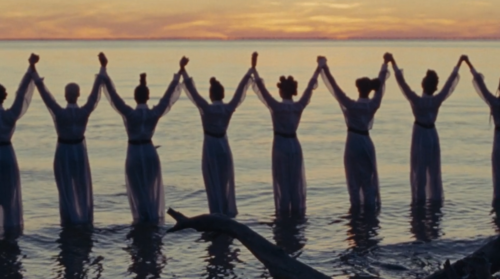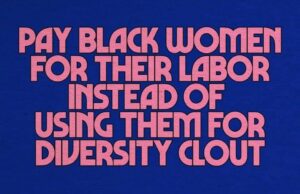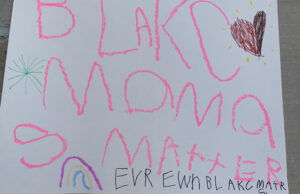#BlackSkinWhiteSin: From Pernicious Editing to Audacious Rescripting (Benediction)
By Tamura Lomax on February 17, 2017 In her Introduction to Skin Deep, Spirit Strong: The Black Female Body in American Culture (2002), an edited collection of essays engaging the hyper-presence of the black female nude in colonial history and the subsequent absence of the same as a subject of beauty, intrigue and desire in the high cultural gazes of Western arts, black feminist, Kimberly Wallace-Sanders posits that Sarah Bartmann, also known as the “Hottentot Venus,” represents perhaps the most “pernicious editing” of black women’s lives and bodies, and more, that many black women feel a kinship with Bartmann because of such re-visioning.
In her Introduction to Skin Deep, Spirit Strong: The Black Female Body in American Culture (2002), an edited collection of essays engaging the hyper-presence of the black female nude in colonial history and the subsequent absence of the same as a subject of beauty, intrigue and desire in the high cultural gazes of Western arts, black feminist, Kimberly Wallace-Sanders posits that Sarah Bartmann, also known as the “Hottentot Venus,” represents perhaps the most “pernicious editing” of black women’s lives and bodies, and more, that many black women feel a kinship with Bartmann because of such re-visioning.
To be sure, the rewriting of lives and bodies has both psychic and material consequences. The beauty and burden of language, discourse and knowledge, however, is that cultural meanings stand in a state of perpetual adaptation, though some interpretations are more deeply rooted and thus more stubborn than others. Still, rather than “awaiting our verb,” we may modify and construct counters. Yet, given the force of modernity’s racist and sexist epistemes, even our counter-narratives may at times prove harmful, occasionally toeing the line of discursive violence. Thus the toils of the cultural worker, among many things, must bend toward not only the undressing of ‘the story’ and subsequent reimagining of a counter, but the literal dismembering and demobilizing of the collective signs, symbols, significations and representations – the taken for granted – the grammar – that articulate messaging, that give life to our utterances, that underpin our beliefs, and that hold our paragraphs and theses together between both periods and bodies.
Frantz Fanon writes in Black Skin, White Mask (1952),
In Europe, the black…is the symbol of evil…The torturer is…black…Satan is black, one talks of shadows, when one is dirty one is black – whether one is thinking of physical dirtiness or of moral dirtiness. It would be astonishing, if the trouble were taken to bring them all together, to see the vast number of expressions that make the black…the equivalent of sin. In Europe, whether concretely or symbolically, the black…stands for the bad side of the character. As long as one cannot understand this fact, one is doomed to talk in circles about the “black problem.” Blackness, darkness, shadow, shades, night, labyrinths of the earth, abysmal depths, blacken someone’s reputation…that is to say, in every civilized and civilizing country, the Negro is the symbol of sin.
And so what does it mean to disentangle black flesh from evil, moral dirtiness and sin? Projecting mass-re-produced white supremacist capitalist patriarchal discourses onto black women and girls’ bodies, sex and identities certainly isn’t the answer. Neither are the respectable subalterns produced by the black middle-class, Black Church, and even some black academicians. Though black folk set out to revise categorical claims about black women and girls’ sexuality for the most part, the counter narratives created sometimes gave credence to the very discourses they meant to deconstruct. And at other times, they muted the wide range of encounters and articulations black women and girls experience. That is, as black protectionist revisionist narratives about black women and girls’ sanctity and respectability rose, so did neo-colonial-primitive discourses on black women and girls’ innate unscrupulousness. And, as discourses on black women and girls’ perversion were circulated and maintained – as an entry point for proving the need for sanctity and delineating between good and bad black women and girls, their complex subjectivity and sexual autonomy were muzzled.
#BlackSkinWhiteSin hoped to revise this. To rescript the narrative. To get underneath meanings. And more, to tear them apart, discredit them and restrain them. Because the only way forward is to resist categorical white supremacist capitalist patriarchal claims about black women and girls’ sexuality – wherever they exist – while refusing the white-washing of protectionist revisionist narratives – while opening our ears to hear the – critical and uncritical – multifaceted declarations of black women and girls’ complex sexual subjectivity – in chorus. This requires collectively rescripting our language. That is, collectively deconstructing meanings, re-approriating and immobilizing old grammars, developing new grammars, and restoring the sins of contact/conquest to whiteness, white history, white culture and white people. These burdens – articulations and deeds – aren’t ours to carry. Return to sender. Of course, there are no neat lines here. This is unquestionably messy work. But in the days ahead, let us refuse the trite intersection between race/gender/class, hyper-sexuality, erotophobia and hyper-moralism. It has never and never will save us.
This is the work the brilliant writers in this forum set out to do. Laboring at and beyond the cross on our collective behalf, the writers travailed to construct alternative openings while proffering new lenses and new language. Furthermore, they reminded us that our bodies are in fact the primary site of our discernment; that our urges, inklings, etc., are bodily and as such are indeed God’s good, righteous, and resolute creation; that our bodies — these honest bodies — are complex and at times deploy contradictory tools in their search for meaning; that we choose to self-adorn in both conventional and unconventional ways and that is just fine and no less divine; and that these bodies…our bodies…our collective fleshly black bodies…reveal a landscape of histories, sensual flourishings, abilities, sacred visions, liberative possibilities, and divine wonder – in unison. And so in the words of Baby Suggs in Beloved, “In this here place, we flesh; flesh that weeps, laughs; flesh that dances on bare feet in grass. Love it. Love it hard.”
Black diasporic wellness requires that black female flesh, in particular, be not only loved but categorically understood as alive, as distinct, as sound, as embodied, as feeling, as free, as previous to contact/conquest, as unquantifiable, as self-determining, as deliberate, as power, as sensual, as foreordained, as having survived, as movement, as spoken, and, yes…God yes…as glorious.
Amen and Ashe.
A complete listing of our offerings below.
#BlackSkinWhiteSin: Received: Black Women and Our Talking Bodies by Neichelle R. Guidry
#BlackSkinWhiteSin: What’s Next: a Bibliography, a Journal and You by Tamura Lomax
 Tamura Lomax, curator of #BlackSkinWhiteSin and “Black Bodies in Ecstasy: Black Women, the Black Church, and the Politics of Pleasure,” is an educator, writer and believer in social justice. She received her Ph.D. from Vanderbilt University in Religion where she specialized in Black Religion and Black Diaspora Studies. In 2014 she published Womanist and Black Feminist Responses to Tyler Perry’s Cultural Productions (Palgrave Macmillan), a co-authored edited volume with Rhon S. Manigault-Bryant and Carol B. Duncan, and is presently finishing up her first single authored monograph, Jezebel Unhinged: Loosing the Black Female Body in Black Religion and Black Popular Culture (Duke University Press). She is co-founder, along with Hortense Spillers, of The Feminist Wire.
Tamura Lomax, curator of #BlackSkinWhiteSin and “Black Bodies in Ecstasy: Black Women, the Black Church, and the Politics of Pleasure,” is an educator, writer and believer in social justice. She received her Ph.D. from Vanderbilt University in Religion where she specialized in Black Religion and Black Diaspora Studies. In 2014 she published Womanist and Black Feminist Responses to Tyler Perry’s Cultural Productions (Palgrave Macmillan), a co-authored edited volume with Rhon S. Manigault-Bryant and Carol B. Duncan, and is presently finishing up her first single authored monograph, Jezebel Unhinged: Loosing the Black Female Body in Black Religion and Black Popular Culture (Duke University Press). She is co-founder, along with Hortense Spillers, of The Feminist Wire.
You may also like...
All Content ©2016 The Feminist Wire All Rights Reserved




1 Comment